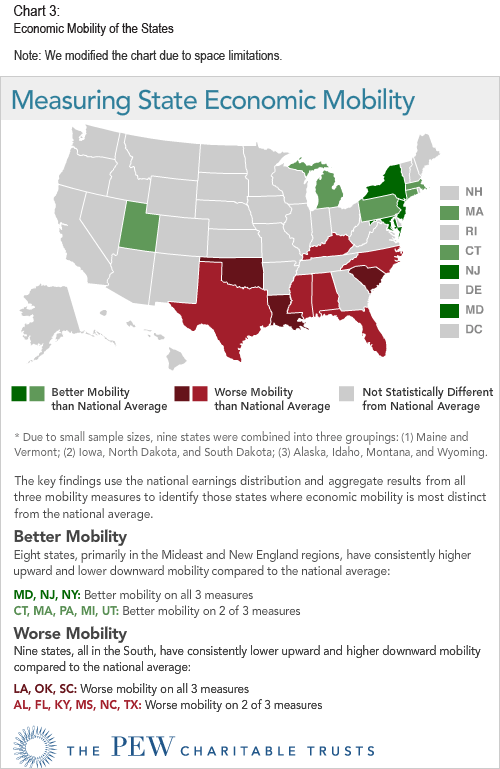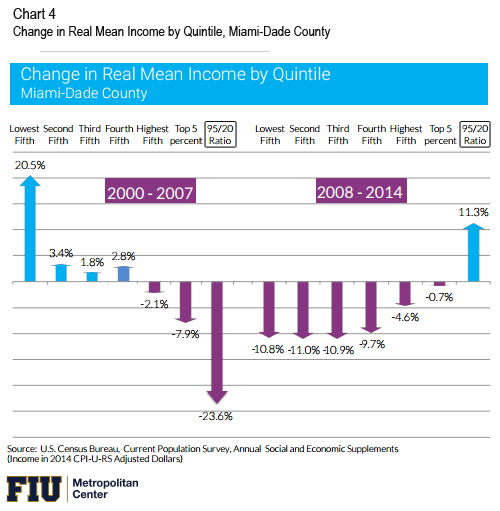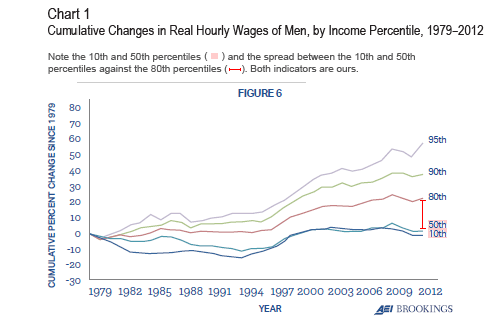
Evidence of increased income inequality and low income mobility in the United States is leading local communities to ask what steps they can take to lay the foundation for economic growth that is both strong and inclusive. In this article, we present evidence on income inequality and economic mobility, highlighting the especially low rates of economic mobility in some parts of the Sixth District. We next look at an early-stage effort in South Florida to improve prosperity for all and create a more resilient local economy. We then discuss some critical foundations necessary to support economic inclusion, and suggest possible resources that may help communities build their infrastructure for inclusion. We conclude by looking at recent economic research indicating inclusion helps support economic growth.
Growing income inequality in the United States
Communities across the country continue to struggle to recover from the Great Recession. Although some statistics—like the unemployment rate—show signs of improvement, longer-term economic data point to a persistent widening of income inequality. This has led many observers' to be concerned that rung on the ladder of economic opportunity are growing further and further apart ![]()
![]() . This income inequality has been driven by wages declining or stagnating for middle- and low-skilled workers, while they continue to rise for those at the top of the income distribution.
. This income inequality has been driven by wages declining or stagnating for middle- and low-skilled workers, while they continue to rise for those at the top of the income distribution.
For example, chart 1 of wages of male workers since 1979 reveals that wages are essentially flat today when compared to 1979 for men at the bottom half of the labor market.1 So while wages continue to rise for those at the top of the income distribution, they are stagnant for those at the bottom and middle.
Beyond increasing income inequality, the United States is also a less economically mobile country than once believed. One Pew Charitable Trusts study in 2012 looked at income levels of adult children compared to their parents' family income and found that 43 percent of those born in the bottom income quintile stay there, while 40 percent of those raised in the top quintile remain there as adults (see chart 2).2 A second study by the Pew Center on the States mapped economic mobility![]() across the country and found nine states, all in the South, consistently show lower upward and higher downward mobility compared to the nation as a whole (see chart 3).3
across the country and found nine states, all in the South, consistently show lower upward and higher downward mobility compared to the nation as a whole (see chart 3).3

Source: The Pew Charitable Trusts, Pursuing the American Dream: Economic Mobility Across Generations

Source: Pew Center on the States, Economic Mobility of the States
Charting a course: Miami-Dade County's Prosperity Initiatives
While the problems of wage stagnation and low economic mobility are national in scale, the solutions may need to be context specific, and therefore driven by a local response. At the Atlanta Fed's Community and Economic Development (CED) department, we have seen communities across the region question ways they can shift their local economy to improve access to opportunity and lay the foundations for a more equitable future. This past May, coauthor Sameera Fazili spoke to one of these communities in South Florida at the Sixth Annual State of the South Florida Economy event.
Miami-Dade County, in partnership with Florida International University's (FIU's) Metropolitan Center, recently took a hard look at its regional economy and asked what more could be done to improve prosperity for all. With support from Citi Community Development, the County Commission's Prosperity Council asked the FIU Metropolitan Center to conduct a feasibility study of potential policy initiatives that could create a stronger foundation for growth at the local level, increase the region's resilience to the national economic cycle, and improve income growth for working families.
FIU's study revealed a regional economy that continued to struggle after the Great Recession. Despite the area's lowest unemployment rate in eight years, poverty levels remained unchanged from 2010–14. In a story familiar to many other regions of the country, the report found the middle-wage jobs lost during the recession have not returned, and instead have been replaced by lower-paying jobs. This weakening of prosperity was a reversal from the 2000–07 period, when Miami-Dade's economy had experienced growing opportunity, rising incomes, and shrinking income inequality across all income segments, especially for those at the bottom 40 percent. Postrecession, however, almost all quintiles saw their fortunes decline, and declines were even steeper for those in the bottom 40 percent in nearly every economic indicator studied (income, income distribution, income disparity, and productivity).4 As a result, the report concludes, today county residents are facing a growing prosperity gap "with declining economic opportunity, mobility, and equity." Additional findings include:5
- Income declines across every income segment in the county from 2000–14 (see chart 4), with only the county's top 5 percent of all households gaining income from 2008–14
- A lower income per income quintile than their respective national averages, with a median household income in 2014 of $42,926, which in real dollars is about 13 percent less than it was in 2000
- An economy creating a preponderance of lower-wage jobs, with 61 percent of jobs created since 2010 paying below the county average wage and only 24 percent of new jobs since 2008 paying more than $50,000 a year
- Income inequality significantly above the national average
- Rapidly rising regional housing and transportation costs, making Miami the third least affordable housing market in the nation
- Identification of particular neighborhoods that have not, and are not, participating in the region's economic growth.

Source: Greiner, Kevin, and Edward Murray, Miami-Dade County Prosperity Initiative Feasibility Study
The five solutions examined would build economic self-sufficiency and help boost the broader local economy. The study looked at the feasibility and impact of the following five proposals:6
- Social enterprise incubators and accelerators
- Community land trusts
- Community benefit agreements
- Children's savings accounts
- Employee-owned business cooperatives7
To maximize impact, the study recommended targeting the programs in neighborhoods of highest need, with the report's authors creating a Neighborhood Distress Index to rank the neediest communities.
The Infrastructure of inclusion
Time will tell if Miami-Dade County's pilot programs, if passed, will be successful in creating more inclusive economic growth, but this first step is a noteworthy one. The region is taking a close and critical look at its economic performance, trying to reach across sectors to implement solutions, gathering data to pinpoint which problems to focus on, and setting baselines to measure their future impact against. The experience implementing these proposals could help inform the national response to rising inequality, if local leaders are able to track and rigorously evaluate their results. Rigorous program evaluation can also help Miami-Dade determine which programs are successful at moving households toward self-sufficiency and the local economy toward shared prosperity.
Our CED department has been talking to communities across our District which, similar to Miami-Dade County, are having public conversations on promoting economic inclusion—from Chattanooga to Nashville to New Orleans to Atlanta. Across all the cities, we hear a common set of questions being asked to build economic resilience of working families:
- What can we do to create quality jobs? Rather than focus on job creation generally, communities are looking for ways to create jobs that pay a family-supporting wage or offer benefits. They do not want to accept a low-wage economy as their only choice. New Orleans made a focused effort to develop "equity as a growth strategy" through the Prosperity NOLA five-year strategic development plan, led by the New Orleans Business Alliance. Implementation has been driven by a cross-sector partnership, the Network for Economic Opportunity, which has developed innovative programs in workforce development and procurement. Together, local government, industry, and philanthropy are creating new ways to connect people and businesses to opportunity, including through employer engagement, targeted outreach and recruitment, and training and skills building.
- How can we help people access a quality job? Once quality jobs have been created, people need to have the skills necessary to perform those jobs, and also pathways to secure the jobs. Local groups are striving to both improve K–12 public education as well as modernize their public workforce development system, as in Chattanooga's work to make sure its residents can access the good-paying jobs the region is now producing. Community leaders also continue efforts to improve affordable housing options in neighborhoods with access to quality schools, services, and jobs or improve transit accessibility for lower-income households, as in Atlanta's TransFormation Alliance's work with the Atlanta Regional Commission to improve equitable transit oriented development.
- How can we help people build assets? For families to move up the economic ladder, they need the ability to withstand short-term shocks, like a sudden illness or a car that won't run. Helping people build savings and assets has become a central focus for some local leaders with efforts ranging from publicly led programs, like Nashville city government's Financial Empowerment Centers to private business-led efforts, like providing small dollar, starter retirement accounts for workers.
The regional benefits of inclusion
Recent economic research indicates that these efforts to improve economic prosperity from the bottom up may also improve an economy's overall economic resilience. A 2011 study by the International Monetary Fund (IMF) looked at factors that correlated with the duration of economic growth spells in a particular country. The economists found that greater income inequality was actually linked to shorter periods of economic growth.8 A follow-up study in 2014 found the results held for advanced economies, like the United States or Europe.9 The more unequal income distribution there was in a country, the less durable and shorter its growth spells. Researchers at the University of Southern California and University of California at Davis wanted to see if these same results held when comparing growth spells across U.S. metropolitan areas. They replicated the IMF's methodology and found, yet again, that lower income inequality was associated with longer spells of economic growth.10 They also found that regions with less spatial segregation were also associated with longer growth spells.11
While deep-rooted patterns of unequal access to opportunity and disinvestment will not change overnight, communities across the region are taking important steps to examine and counter their economic disparities, in an effort to build more durable local economic growth in the future.
By Sameera Fazili, senior CED visiting adviser, and Mary Hirt, CED intern
_______________________________________
1 AEI/Brookings. Opportunity, Responsibility, and Security Report. 2015.
2 The Pew Charitable Trusts. Pursuing the American Dream: Economic Mobility Across Generations. Washington, DC, 2012.
3 Pew Center on the States. Economic Mobility of the States. Washington, DC: Economic Mobility Project, 2012.
4 Greiner, Kevin, and Edward Murray. Miami-Dade County Prosperity Initiative Feasibility Study. Florida International University's Metropolitan Center, 2016.
5 Ibid (see footnote 4).
6 Ibid.
7 Analyses of some of these types of economic inclusion programs are available on the FedCommunities.org website, which provides a comprehensive database on community development resources across the Federal Reserve System. For example, the Boston Fed has a special focus on children's savings accounts.
8 Berg, Andrew, and Jonathan Ostry. Inequality and Unsustainable Growth: Two Sides of the Same Coin? IMF, 2011.
9 Berg, Andrew, Jonathan Ostry, and Charalambos Tsangarides. Redistribution, Inequality, and Growth. IMF, 2014.
10 Benner, Chris and Manuel Pastor. Buddy, Can You Spare Some Time? Social Inclusion and Sustained Prosperity in America's Metropolitan Regions. The University of California Berkeley's Building Resilient Regions Institute of Governmental Studies, 2013.
11 Ibid (see footnote 10).




